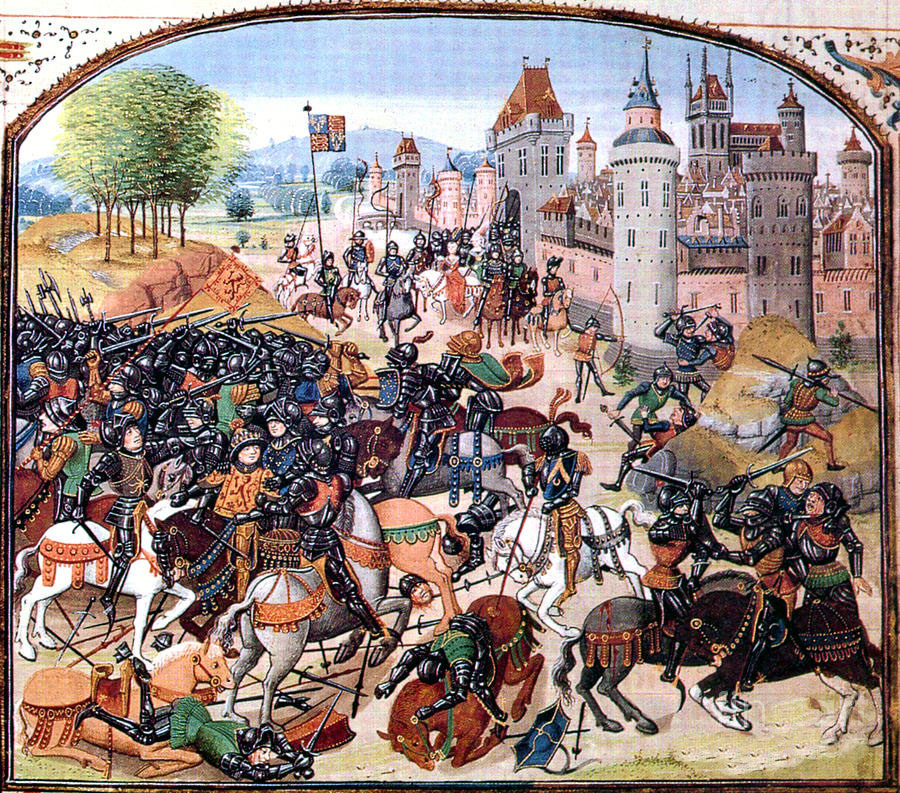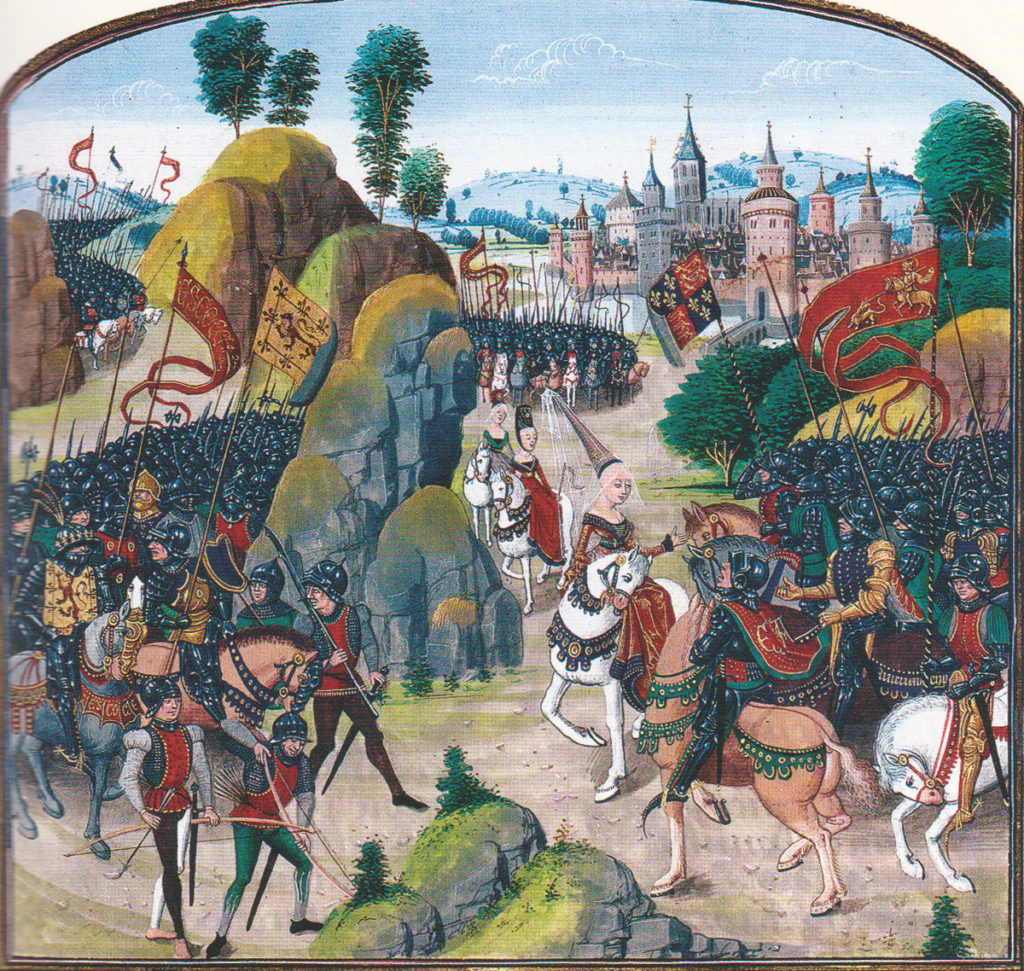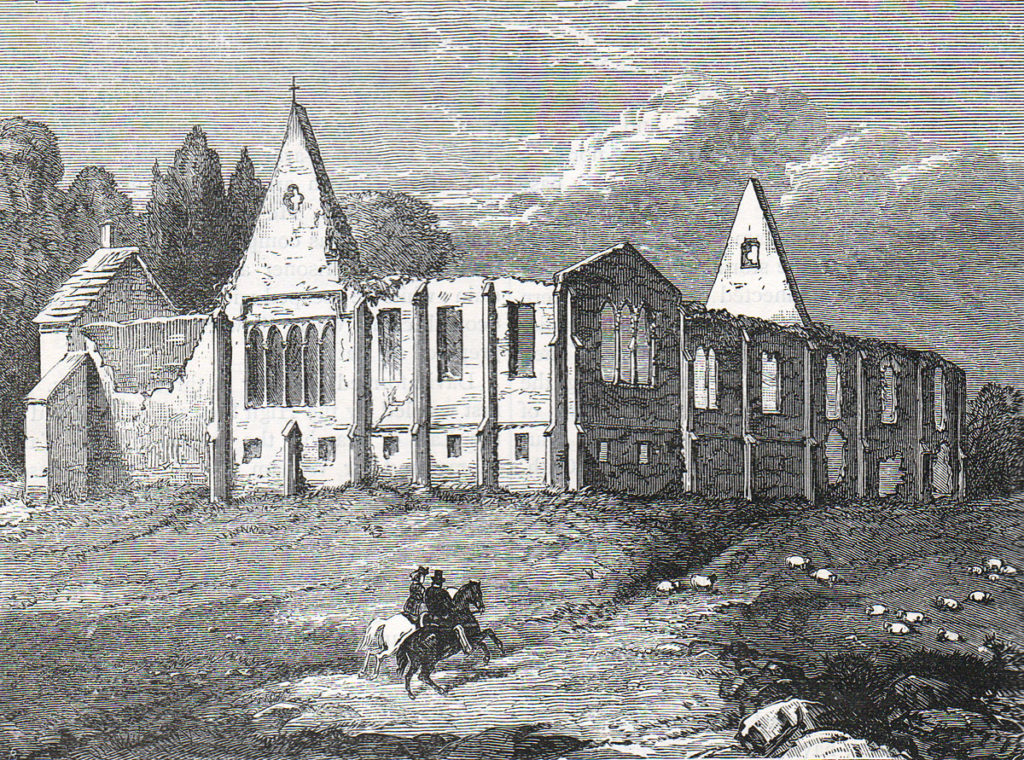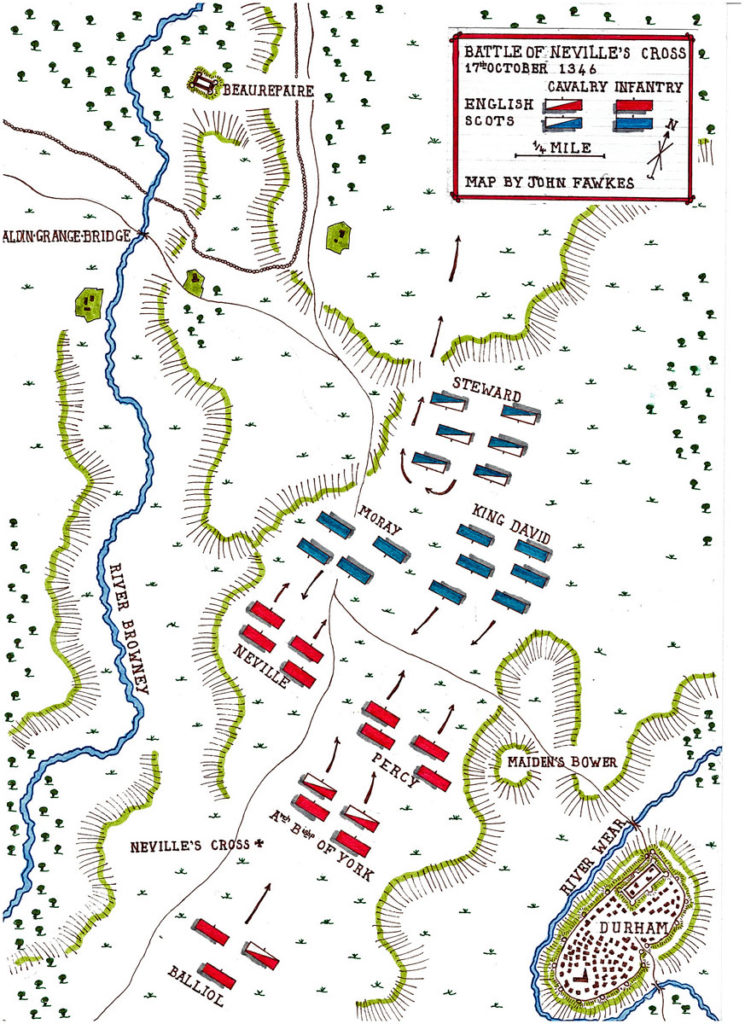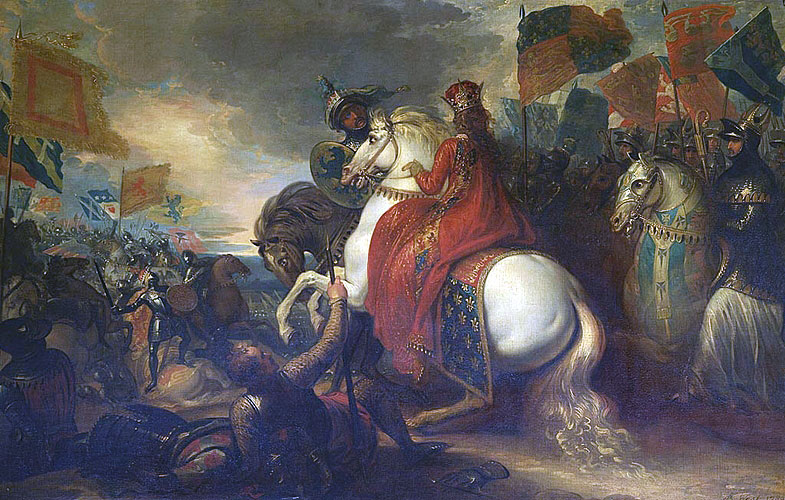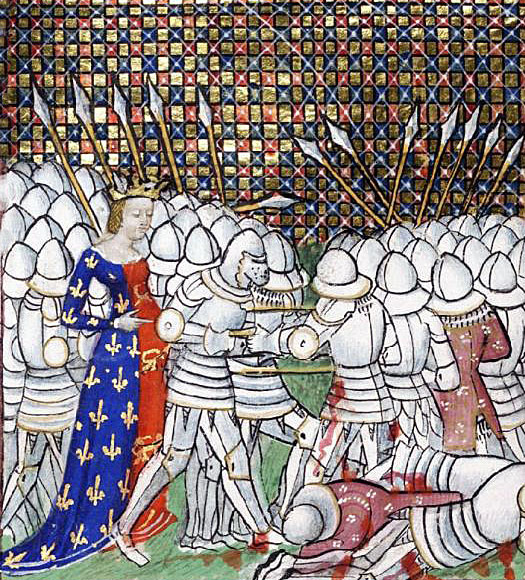The crushing defeat on 17th October 1346 of David II, son of Robert the Bruce and King of Scotland, whose capture and the loss of several of Scotland’s military leaders left Scotland helpless for many years
The previous battle of the Hundred Years War is the Siege of Calais
The next battle of the Hundred Years War is the Battle of La Roche-Derien
Date of the Battle of Neville’s Cross: 17th October 1346.
Place of the Battle of Neville’s Cross: Durham in the North of England.
Combatants at the Battle of Neville’s Cross: an invading Scots army against a Northern English army.
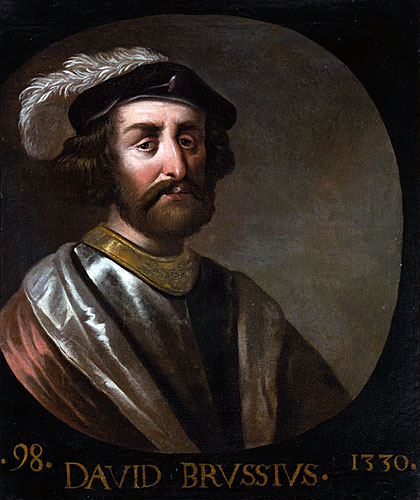
Commanders at the Battle of Neville’s Cross: King David II of Scotland against Henry Percy, Ralph Neville and the Warden of the Eastern March, Walter de la Zouche, Archbishop of York.
Size of the armies at the Battle of Neville’s Cross: The Scottish army probably numbered around 10,000 men while the English army numbered around 6,000 men.
Uniforms, arms and equipment at the Battle of Neville’s Cross: The Scots army was made up of a small core of noblemen and knights on horseback, equipped with armour, lance, shield, sword and dagger.
Depending upon wealth and rank a mounted knight wore jointed steel armour incorporating back and breast plates, a visored bascinet helmet and steel plated gauntlets with spikes on the back; the legs and feet protected by steel greaves and boots, called jambs. Weapons carried were a lance, shield, sword and dagger. Over the armour a knight wore a jupon or surcoat emblazoned with his arms and an ornate girdle.
The majority of the Scots soldiers were fighting men armed with a wide range of striking weapons and pikes formed into ‘schiltrons’ or divisions.
While there were archers in the Scots army they were not as numerous or as effective as the English archers.
As was frequently the practice once battle was closed the two leading Scots divisions, commanded by the Earl of Moray and King David dismounted and fought on foot.
The English army was similar in make-up except that it comprised a substantial force of archers, many experienced fighting men.
The weapon of the English archers was a six-foot yew bow discharging a feathered arrow a cloth metre in length. Arrows were fired with a high trajectory, descending on the approaching foe at an angle. The rate of fire was up to one arrow every 5 seconds. For close quarter fighting the archers used hammers or daggers to batter at an adversary’s armour or penetrate between the plates.
the particular strength of the English army lay in its archers with their life-time of training in the use of the longbow enabling them to deliver a storm of arrows at a high rate of fire.
Winner of the Battle of Neville’s Cross: The English army decisively.
Background to the Battle of Neville’s Cross:
The Scottish King David II, son of Robert the Bruce, returned to Scotland in 1341 after an exile of seven years in France, taking over his kingdom from the succession of Guardians who had attempted to maintain his rule following the death of his father King Robert (Robert the Bruce).
David’s rival for the Scottish throne, Edward Balliol, enjoyed the support of King Edward III of England.
Following King Edward III’s invasion of France in 1346, leading to the Battle of Creçy and the siege of the French Channel Port of Calais, King Philip VI of France invoked the ‘Auld Alliance’ between France and Scotland, urging the King of Scotland to attack Northern England, thereby providing a distraction for the English from their invasion of France.
It was the belief of the Scots, encouraged by the French, that all the fighting men of England were with King Edward III’s army in France, leaving “only priests, friars, clerks, craftsmen and tradesmen” to resist a Scots invasion of Northern England.
This belief was incorrect. When Edward raised his army for the invasion of France, remaining deeply suspicious of the Scots, he did not recruit from the counties north of the River Humber, ensuring there remained a reservoir of troops available to deal with any Scots invasion of Northern England.
King David assembled his Scots army at Perth in September 1346. Among its leaders were his nephew, Robert Stewart, the Steward of Scotland, the Earl of March, William Douglas of Liddesdale, the Earl of Moray, the Marischal, the Lord Constable and the Earls of Menteith, Wigtown, Sutherland and Strathearn.
On 7th October 1346, King David invaded England with an army of around 12,000 men, including some French knights.
Crossing into England at the western end of the Anglo-Scottish border, the Scottish army, instead of marching quickly south to exploit the surprise of the invasion, halted inside the border to lay siege to the castle known as the ‘Peel of Liddell’, described as a ’Powerful Natural Fortress’.
After three days of siege the Peel of Liddell was stormed. The English governor, Sir Walter Selby, a turncoat officer of the Scots King, was captured and executed. The castle, a largely wooden motte and bailey was destroyed.
The citizens of nearby Carlisle paid King David a large indemnity to preserve their town from pillage and the Scots turned south-east, heading for the wealthy city of Durham.
The Scots army spread out as it advanced, enabling its soldiers to pillage a wide swathe of the countryside.
King David halted for three days at Hexham, where his soldiers plundered the Great Priory.
King David’s army reached Durham on 16th October 1346 and encamped at Beaurepaire (now Bear Park), the country seat of the prior of the city’s cathedral monastery to the west of the city.
The monks of the monastery offered to pay a ransom of £1,000 to the Scots to protect their foundation and city from being pillaged, payable on 18th October 1346.
King David agreed and awaited the payment.
Account of the Battle of Neville’s Cross:
Three English officials were responsible for countering the Scottish invasion: the two commanders of the border, Henry Percy and Ralph Neville and the Warden of the Eastern March, Walter de la Zouche, Archbishop of York.
These three officials had been aware of the Scottish invasion plans, through their spies in Scotland and Northern England.
An English army assembled under the Archbishop of York at Richmond in North Yorkshire, comprising some 4,000 men of the northern counties, with a further 3,000 Yorkshiremen marching from the southern part of the county to join them.
A substantial proportion of the English army was made up of longbowmen, 1,200 of them from Lancashire.
The English army marched from Richmond to Barnard’s Castle, without waiting for the force from South Yorkshire, where the Archbishop formed his troops into three divisions, before continuing the English advance to Durham.
on 17th October 1346 William Douglas was raiding south of Durham with a small Scots force when he encountered two of the English Divisions at Ferryhill.
There was a fight in which the Scots were driven back with heavy casualties.
Douglas hurriedly returned to the Scots camp at Beaurepaire during the morning of 17th October 1346 and warned King David of the imminent approach of the English force, this being the first notice the Scottish King had of English armed resistance to the Scots invasion, other than the resistance of the Peel of Liddell garrison.
King David turned out his army and marched it out to an area of moorland on which stood a stone monument called ‘Neville’s Cross’.
The three divisions of the Scots army, the van commanded by the Earl of Moray, the King’s own division and the reserve division, commanded by the Steward, took up positions amongst the dykes and walls that broke up the area.
The rival armies formed for battle a quarter of a mile apart on the difficult moorland.
While both armies were in position by late morning the fighting did not begin until the early afternoon.
Archers on the English left flank advanced into range and began a discharge at the Scots line, firing into the division on the Scots right flank commanded by the Earl of Moray.
It is said that John Graham, the Earl of Menteith, having attempted unsuccessfully to lead a general attack by the Scots, rode alone at the archers until his horse was wounded by an arrow and he was forced to withdraw.
Moray led his division forward to counter the English bowmen and while initially successful the Scots advance was broken up by the difficult country and counter-attacks by English knights and men-at-arms.
The larger division, led by King David, advanced into the battle, joining the increasingly dispersed men of Moray’s division, but were also hampered by the dykes and walls of the broken moorland.
The Steward’s third division declined to join the battle and retreated from the battlefield, riding off on horseback and leaving the two leading divisions to follow on foot, pressed by the English attack.
Falling back with his disordered division and with two arrow wounds in his face, King David was captured. Barely forty Scots soldiers were left alive attempting to defend their king.
The remnants of the Scots army were pursued for twenty miles across the Durham countryside.
Casualties at the Battle of Neville’s Cross: English casualties were said to have been few while the Scots were said to have lost around 3,000 dead. Sumption states that it was characteristic of a Medieval battle for casualties to be relatively low until one side broke and fled when heavy losses were liable to be inflicted on the fleeing side during the pursuit.
Among the prominent Scotsmen killed in the battle were the Marischal of Scotland, the Chamberlain, Chancellor and the Constable, the Earls of Moray and Strathearn and the king’s half-brother Neil of Carrick.
Graham of Liddesdale, the Earls of Menteith, Wigtown, Sutherland and Fife were captured.
Menteith was executed for treason allegedly to Edward Balliol.
Follow-up to the Battle of Neville’s Cross: Following the battle, King David was taken to Bamburgh Castle where his wounds were treated by English surgeons before being moved to the Tower of London.
On his journey King David was paraded through London on a black horse. He was finally incarcerated at Odiham Castle until he was ransomed and released by King Edward III in 1357.
Anecdotes and traditions from the Battle of Neville’s Cross:
- During his advance to Durham King David is reputed to have been visited in a dream by St Cuthbert who asked him not to violate his lands. St Cuthbert was the patron saint of Northumbria with his tomb in Durham Cathedral.
- During the Battle of Neville’s Cross the Prior of Durham led his monks out onto a hill called ‘the Maiden’s Bower’, where they sang and prayed during the course of the battle. The Prior is alleged to have been visited by St Cuthbert who ordered him to take his monks to the battlefield carrying St Cuthbert’s communion cloth.
- It is said that during the retreat King David took refuge under a bridge, reputed to have been Aldin Grange Bridge, but his reflection was seen by English soldiers crossing the bridge and he was taken by John de Coupland, although knocking out two of Coupland’s teeth with his mailed fist during the struggle. Coupland handed the King to Royal officers. Coupland’s reward from King Edward III was to be knighted and awarded a pension of £500 a year.
- The name of the battle, ‘Neville’s Cross’ is said to come from the memorial erected by Neville after the battle.
- Many of the images of the Battle of Neville’s Cross show Queen Philippa. The Queen was not at the battle being in France with King Edward III.
References for the Battle of Neville’s Cross:
Trial by Battle, Volume I of the four volume record of the Hundred Years War by Jonathan Sumption.
The Art of War in the Middle Ages Volume Two by Sir Charles Oman.
The Hundred Years War by Robin Neillands.
British Battles by Grant.
The previous battle of the Hundred Years War is the Siege of Calais
The next battle of the Hundred Years War is the Battle of La Roche-Derien
